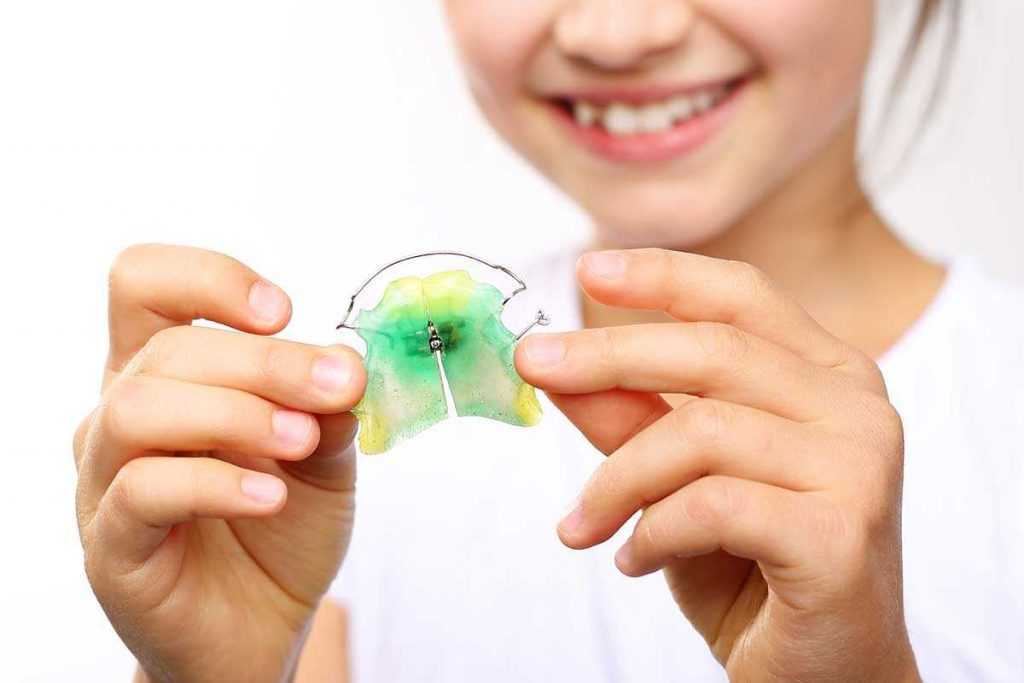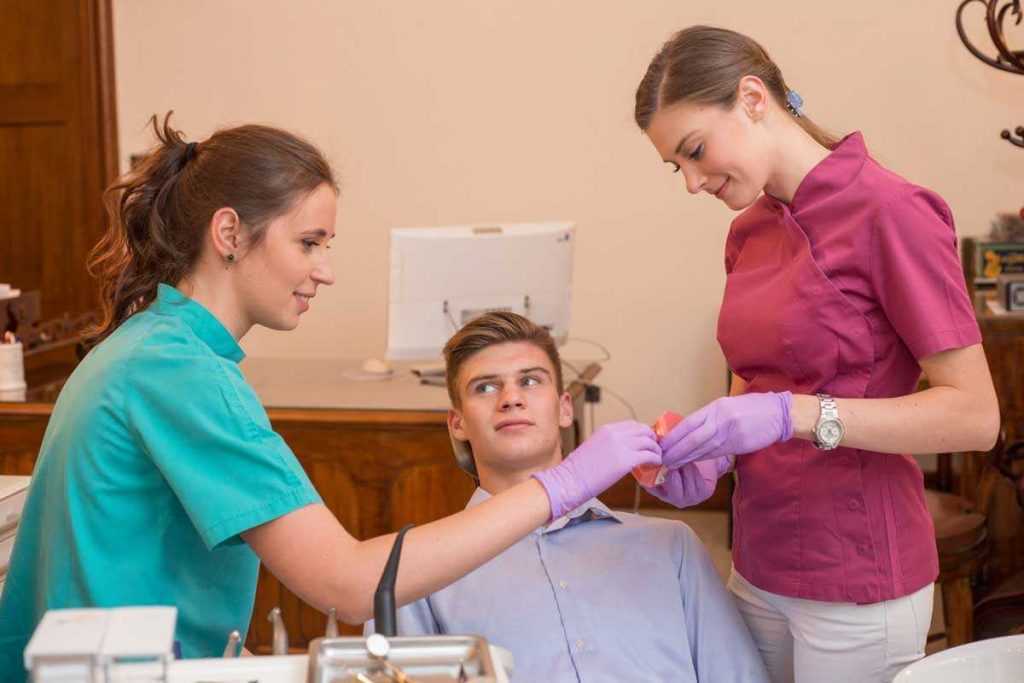Mobile orthodontic appliances are intended for children, and we apply them even before the start of deciduous teeth falling out. At that age, mobile orthodontic appliances have an important role to guide growth and guarantee proper development of the jaws.
What will you learn in this article?
In this article, read about the following topics:
- Types of mobile orthodontic appliances
- What is interceptive therapy?
- At what age do children start wearing orthodontic appliances?
- How should a mobile orthodontic appliance be worn?
- How long is a mobile orthodontic appliance worn?
Types of mobile orthodontic appliances
First of all, it should be clarified why this type of orthodontic appliance is called “mobile“ because the patient can take out a mobile device from their mouth and put it back into place.
In contrast, fixed orthodontic appliances are firmly placed on the teeth until orthodontic therapy is complete.
Both play an important role in the orthodontics of children, young people and adults.
Bimaxillary and monomaxillary orthodontic appliances
There are several types of mobile orthodontic appliances, depending on the purpose, goal which we want to achieve or the manner of wearing. We usually divide them into bimaxillary and monomaxillary mobile orthodontic appliances.
Bimaxillary mobile orthodontic appliances
Bimaxillary or single-piece mobile orthodontic appliances consist of one device that simultaneously encompasses and acts on the upper and lower jaw.
They are made of plastic or rubber and can be in various colours or transparent.
With a bimaxillary mobile orthodontic appliance, we will encourage, accelerate, i.e. slow down the development of the jaw and teeth, and thus prevent their irregular growth.
We often use them, among other things, for correction of irregularities in growth that occur as a result of sucking thumbs or pacifiers.

Monomaxillary mobile orthodontic appliance
Monomaxillary or two-piece mobile orthodontic appliances consist of two appliances, one for each jaw.
They are made of an acrylic base to which the steel wires are attached. The acrylic base can also be manufactured in a variety of colours, which makes young patients happy and motivates them to wear an orthodontic appliance.
The upper and lower part of a monomaxillary orthodontic appliance actively acts on the teeth. With the help of steel wires, clips and screws, for example, they widen dental arches or rotate teeth and thus direct their growth.
They are especially useful in case of premature loss of a deciduous tooth. Then it is important to preserve spacefor a permanent tooth that has not yet erupted.
All of the above describes the main objectives of interceptive orthodontic therapy which we strongly advocate as orthodontics specialists.

What is interceptive therapy?
Orthodontic therapy that “works with growth”, i.e., it begins in the period of intensive growth of the child, is called interceptive orthodontic therapy.
The time of the beginning of intensive growth of the child is individual, and the goal of orthodontic therapy is to encourage or slow down the growth of the upper and / or lower jaw during this period and to enable balance in jaw development.
The severity of the orthodontic anomaly can thus be significantly reduced so later fixed orthodontic therapy can be a lot less intense and shorter.
Growth guidance or interceptive therapy can sometimes completely remove the need for fixed orthodontic therapy.
Worried about the possible irregularity of your child’s bite?
Our orthodontics specialists can prevent the development of these irregularities into serious problems with bite or speech.
Contact us if you need advice or have questions.
Get a professional checkup without leaving your home!
We offer you a virtual dental examination. Learn more!
We will make a correct individual estimate for each child, determine the order of treatment of recognized growth irregularities and establish individual orthodontic therapy.
Therefore, it is possible for a child in the phase of tooth change and growth to change more than one orthodontic appliance.
Such targeted treatment of orthodontic anomalies is most successful according to the rules and recommendations of leading international professional societies.

At what age do children start wearing orthodontic appliances?
Parents are advised to visit an orthodontist when the child turns 7. One of the indications for a mandatory visit to an orthodontist is the start of deciduous teeth falling out.
Development of the jaw and the growth of teeth in each child is different. Therefore, a first visit to an orthodontist does not mean the immediate start of orthodontic therapy.
First of all, we want to see the directions of jaw growth and in relation to that predict when it is best that your child starts wearing their first orthodontic appliance.
Mobile orthodontic appliances are most commonly used in children and young people who are still growing.
During this period, we will correct with mobile orthodontic appliances the relations between the jaws, stop bad habits, fix irregularities in bite height, swallowing and speech, and begin to save space for unerupted permanent teeth.
Limited effectiveness of mobile functional orthodontic appliance
The effectiveness of mobile functional or interceptive orthodontic appliances during adolescence when jaw growth ends. We could say that its effectiveness is conditioned by the process of jaw development.
This is because the principle of the mobile functional orthodontic appliance is such that it directs growth, acting as an orthopaedic tool for more proper jaw development.
A visit to an orthodontist, as well as wearing a mobile orthodontic appliance, is therefore important to anticipate in early stages of the child’s development.
How should a mobile orthodontic appliance be worn?
Mobile orthodontic appliances should be worn according to the following rule: if the period of wearing an orthodontic appliance during the day and night is in total longer than the period of not wearing by at least 4 hours, therapy will be effective.
Here are some more specific tips:
- It is recommended that the child wear a mobile orthodontic appliance at least 14 hours daily.
- During the adjustment period, during the first 10 days, make sure that the child does not unconsciously ejected the orthodontic appliance from their mouth during sleep.
- A mobile orthodontic appliance is required to be taken out before meals, washed and to dried.
- Be careful that the child does not neglect dental hygiene while wearing a mobile appliance.
- After eating, teeth must first be washed, and only then should the orthodontic appliance be returned.
How long is a mobile orthodontic appliance worn?
It has already been emphasized that every orthodontic therapy is individual. Therapy with mobile orthodontic appliances depends on the intensity of the child’s growth and the replacement of teeth.
The duration will also depend on the degree of orthodontic anomaly, but also the level of discipline wearing the mobile orthodontic appliance.
It often turns out that the weakest side of mobile orthodontic therapy is exactly that it depends on the discipline of patients who are actually still children.
Have you found everything you wanted to know?
In this article you have learnt more about mobile orthodontic appliances. You may also be interested in other topics, such as:
- Fixed orthodontic appliances
- Aesthetic orthodontic appliances
- What is Invisalign and is it right for you?
- Our orthodontic protocol
Our orthodontics specialists will be happy to answer all your questions.
With thousands of successful orthodontic therapies and the most modern diagnostics, we believe that we can find a solution for the proper growth of your child’s teeth.
Contact us if you need advice or have questions.
Get a professional checkup without leaving your home!
We offer you a virtual dental examination. Learn more!


